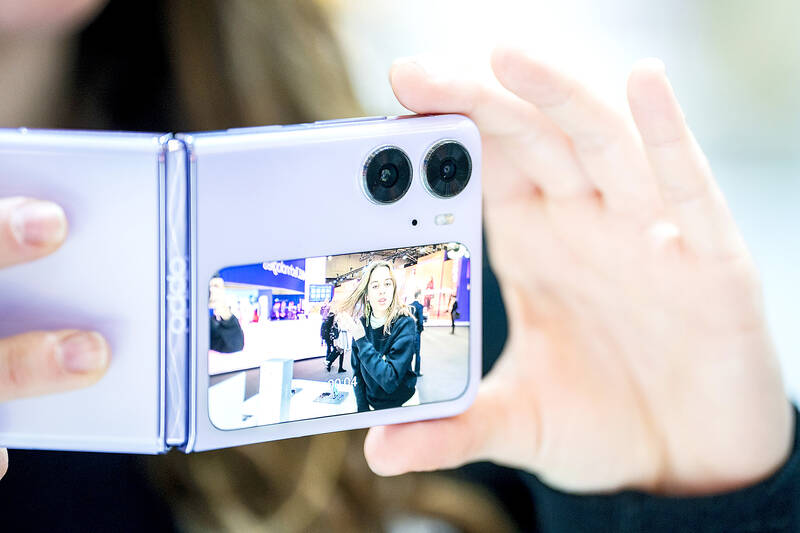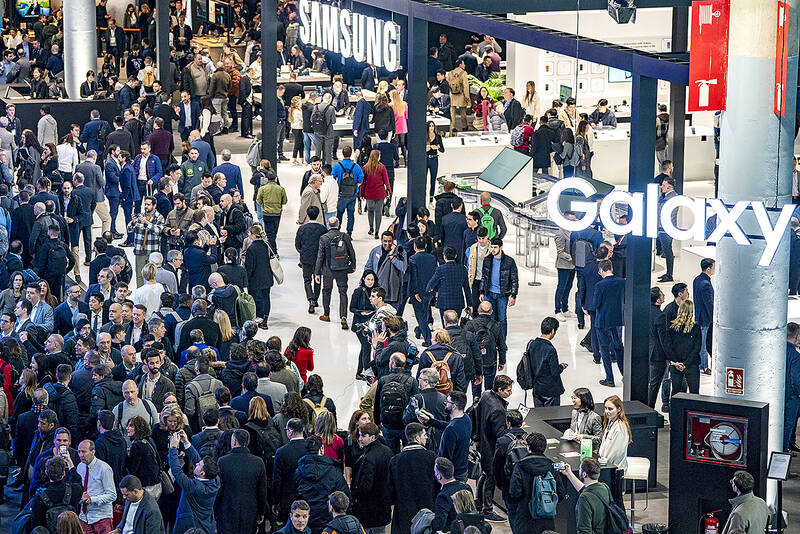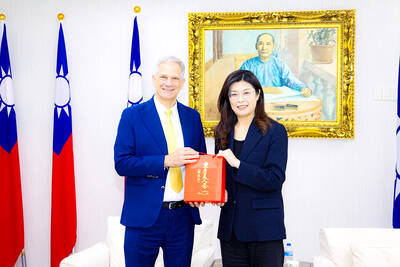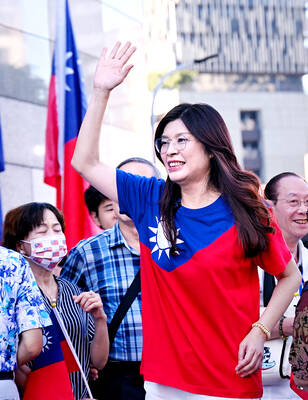The man credited with inventing the cellphone 50 years ago had only one concern then about the brick-sized device with a long antenna: Would it work?
These days Martin Cooper frets like everybody else about his invention’s impacts on society — from the loss of privacy to the risk of internet addiction to the rapid spread of harmful content, especially among kids.
“My most negative opinion is we don’t have any privacy anymore because everything about us is now recorded someplace and accessible to somebody who has enough intense desire to get it,” said Cooper, who spoke at the telecom industry’s biggest trade show in Barcelona, where he was receiving a lifetime award.

Photo: AP
Yet the 94-year-old self-described dreamer also marvels at how far cellphone design and capabilities have advanced, and he believes the technology’s best days may still be ahead of it in areas such as education and health care.
“Between the cellphone and medical technology and the Internet, we are going to conquer disease,” he said Monday at MWC, or Mobile World Congress.
Cooper, whose invention was inspired by Dick Tracy’s radio wristwatch, said he also envisions a future in which cellphones are charged by human bodies.

Phots: AP
It’s a long way from where he started.
Cooper made the first public call from a handheld portable telephone on a New York City street on April 3, 1973, using a prototype that his team at Motorola had started designing only five months earlier.
To needle the competition, Cooper used the Dyna-TAC prototype — which weighed 2.5 pounds and was 11 inches long — to call to his rival at Bell Labs, owned by AT&T.
“The only thing that I was worried about: ‘Is this thing going to work?’ And it did,” he said.
The call helped kick-start the cellphone revolution, but looking back on that day Cooper acknowledges, “we had no way of knowing this was the historic moment.”
He spent the better part of the next decade working to bring a commercial version of the device to market, helping to launch the wireless communications industry and, with it, a global revolution in how we communicate, shop and learn about the world.
Still, Cooper said he’s “not crazy” about the shape of modern smartphones, blocks of plastic, metal and glass. He thinks phones will evolve so that they will be “distributed on your body,” perhaps as sensors “measuring your health at all times.”
Batteries could even be replaced by human energy.
“You ingest food, you create energy. Why not have this receiver for your ear embedded under your skin, powered by your body?” he imagined.
While he dreams about what the future might look like, Cooper is attuned to the industry’s current challenges, particularly around privacy.
In Europe, where there are strict data privacy rules, regulators are concerned about apps and digital ads that track user activity, allowing technology and other companies to build up rich profiles of users.
“It’s going to get resolved, but not easily,” Cooper said. “There are people now that can justify measuring where you are, where you’re making your phone calls, who you’re calling, what you access on the Internet.”
Smartphone use by children is another area that needs limits, Cooper said. One idea is to have “various Internets curated for different audiences.”
Five-year-olds should be able to use the internet to help them learn, but “we don’t want them to have access to pornography and to things that they don’t understand,” he said.
As for his own phone use, Cooper says he checks email and does online searches for information to settle dinner table arguments.
However, “there are many things that I have not yet learned,” he said. “I still don’t know what TikTok is.”

Seven hundred job applications. One interview. Marco Mascaro arrived in Taiwan last year with a PhD in engineering physics and years of experience at a European research center. He thought his Gold Card would guarantee him a foothold in Taiwan’s job market. “It’s marketed as if Taiwan really needs you,” the 33-year-old Italian says. “The reality is that companies here don’t really need us.” The Employment Gold Card was designed to fix Taiwan’s labor shortage by offering foreign professionals a combined resident visa and open work permit valid for three years. But for many, like Mascaro, the welcome mat ends at the door. A

If China attacks, will Taiwanese be willing to fight? Analysts of certain types obsess over questions like this, especially military analysts and those with an ax to grind as to whether Taiwan is worth defending, or should be cut loose to appease Beijing. Fellow columnist Michael Turton in “Notes from Central Taiwan: Willing to fight for the homeland” (Nov. 6, page 12) provides a superb analysis of this topic, how it is used and manipulated to political ends and what the underlying data shows. The problem is that most analysis is centered around polling data, which as Turton observes, “many of these

Since Cheng Li-wun (鄭麗文) was elected Chinese Nationalist Party (KMT) chair on Oct. 18, she has become a polarizing figure. Her supporters see her as a firebrand critic of the ruling Democratic Progressive Party (DPP), while others, including some in her own party, have charged that she is Chinese President Xi Jinping’s (習近平) preferred candidate and that her election was possibly supported by the Chinese Communist Party’s (CPP) unit for political warfare and international influence, the “united front.” Indeed, Xi quickly congratulated Cheng upon her election. The 55-year-old former lawmaker and ex-talk show host, who was sworn in on Nov.

Even the most casual followers of Taiwan politics are familiar with the terms pan-blue and pan-green. The terms are used so casually and commonly with the assumption that everyone knows what they mean, that few stop to really question it. The way these terms are used today is far broader and extensive than what they were originally created to represent. Are these still useful shorthand terms, or have people become so obsessed with them that they color perceptions to the point of distortion? LEE TUNG-HUI WAS NO SMURF People often assume that these terms have been around forever, or at least as